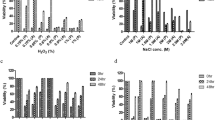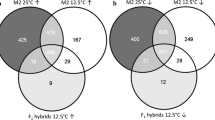Abstract
Cellular responses of Saccharomyces cerevisiae to high temperatures of up to 42 °C during ethanol fermentation at a high glucose concentration (i.e., 100 g/L) were investigated. Increased temperature correlated with stimulated glucose uptake to produce not only the thermal protectant glycerol but also ethanol and acetic acid. Carbon flux into the tricarboxylic acid (TCA) cycle correlated positively with cultivation temperature. These results indicate that the increased demand for energy (in the form of ATP), most likely caused by multiple stressors, including heat, acetic acid, and ethanol, was matched by both the fermentation and respiration pathways. Notably, acetic acid production was substantially stimulated compared to that of other metabolites during growth at increased temperature. The acetic acid produced in addition to ethanol seemed to subsequently result in adverse effects, leading to increased production of reactive oxygen species. This, in turn, appeared to cause the specific growth rate, and glucose uptake rate reduced leading to a decrease of the specific ethanol production rate far before glucose depletion. These results suggest that adverse effects from heat, acetic acid, ethanol, and oxidative stressors are synergistic, resulting in a decrease of the specific growth rate and ethanol production rate and, hence, are major determinants of cell stability and ethanol fermentation performance of S. cerevisiae at high temperatures. The results are discussed in the context of possible applications.







Similar content being viewed by others

References
Abbott DA, Zelle RM, Pronk JT, van Maris AJA (2009) Metabolic engineering of Saccharomyces cerevisiae for production of carboxylic acids: current status and challenges. FEMS Yeast Res 9:1123–1136
Aceituno FF, Orellana M, Torres J, Mendoza S, Slater AW, Melo F, Agosin E (2012) Oxygen response of the wine yeast Saccharomyces cerevisiae EC1118 grown under carbon-sufficient, nitrogen-limited enological conditions. Appl Environ Microbiol 78:8340–8352
Aldiguier AS, Alfenore S, Cameleyre X, Goma G, Uribelarrea JL, Guillouet SE, Molina-Jouve C (2004) Synergistic temperature and ethanol effect on Saccharomyces cerevisiae dynamic behaviour in ethanol bio-fuel production. Bioproc Biosyst Eng 26:217–222
Blank LM, Lehmbeck F, Sauer U (2005) Metabolic-flux and network analysis in fourteen hemiascomycetous yeasts. FEMS Yeast Res 5:545–558
Blank LM, Ebert BE, Buehler K, Bühler B (2010) Redox biocatalysis and metabolism: molecular mechanisms and metabolic network analysis. Antioxid Redox Sign 13:349–394
Bolten CJ, Kiefer P, Letisse F, Portais JC, Wittmann C (2007) Sampling for metabolome analysis of microorganisms. Anal Chem 79:3843–3849
Çakır T, Kirdar B, Önsan ZI, Ülgen KO, Nielsen J (2007) Effect of carbon source perturbations on transcriptional regulation of metabolic fluxes in Saccharomyces cerevisiae. BMC Syst Biol 1:18
Cartwright CP, Veazey FJ, Rose AH (1987) Effect of ethanol on activity of the plasma-membrane ATPase in, and accumulation of glycine by Saccharomyces cerevisiae. J Gen Microbiol 133:857–865
Celton M, Sanchez I, Goelzer A, Fromion V, Camarasa C, Dequin S (2012a) A comparative transcriptomic, fluxomic and metabolomic analysis of the response of Saccharomyces cerevisiae to increases in NADPH oxidation. BMC Genomics 13:317
Celton M, Goelzer A, Camarasa C, Fromion V, Dequin S (2012b) A constraint-based model analysis of the metabolic consequences of increased NADPH oxidation in Saccharomyces cerevisiae. Met Eng 14:366–379
Covert MW, Famili I, Palsson BO (2003) Identifying constraints that govern cell behavior: a key to converting conceptual to computational models in biology? Biotechnol Bioeng 84:763–772
Edwards JS, Covert M, Palsson B (2002) Metabolic modelling of microbes: the flux-balance approach. Environ Microbiol 4:133–140
Gómez-Pastor R, Pérez-Torrado R, Cabiscol E, Ros J, Matallana E (2010) Reduction of oxidative cellular damage by overexpression of the thioredoxin TRX2 gene improves yield and quality of wine yeast dry active biomass. Microb Cell Fact 9:9
Graça da Silveira M, San Romão MV, Loureiro-Dias MC, Rombouts FM, Abee T (2002) Flow cytometric assessment of membrane integrity of ethanol-stressed Oenococcus oeni cells. Appl Environ Microbiol 68:6087–6093
Herrero E, Ros J, Belli G, Cabiscol E (2008) Redox control and oxidative stress in yeast cells. Biochim Biophys Acta-Gen Sub 1780:1217–1235
Heyland J, Fu JA, Blank LM (2009) Correlation between TCA cycle flux and glucose uptake rate during respiro-fermentative growth of Saccharomyces cerevisiae. Microbiology-SGM 155:3827–3837
Kang A, Tan MH, Ling H, Chang MW (2013) Systems-level characterization and engineering of oxidative stress tolerance in Escherichia coli under anaerobic conditions. Mol BioSyst 9:285–295
Kim IS, Moon HY, Yun HS, Jin I (2006) Heat shock causes oxidative stress and induces a variety of cell rescue proteins in Saccharomyces cerevisiae KNU5377. J Microbiol 44:492–501
Lee DY, Yun H, Park S, Lee SY (2003) MetaFluxNet: the management of metabolic reaction information and quantitative metabolic flux analysis. Bioinformatics 19:2144–2146
López-Mirabal HR, Winther JR (2008) Redox characteristics of the eukaryotic cytosol. Biochim Biophys Acta-Mol Cell Res 1783:629–640
Ludovico P, Sousa MJ, Silva MT, Leão C, Côrte-Real M (2001) Saccharomyces cerevisiae commits to a programmed cell death process in response to acetic acid. Microbiology-SGM 147:2409–2415
Ma MG, Liu ZL (2010) Mechanisms of ethanol tolerance in Saccharomyces cerevisiae. Appl Microbiol Biotechnol 87:829–845
Morano KA, Grant CM, Moye-Rowley WS (2012) The response to heat shock and oxidative stress in Saccharomyces cerevisiae. Genetics 190:1157–1195
Neves M-J, François J (1992) On the mechanism by which heat shock induces trehalose accumulation in Saccharomyces cerevisiae. Biochem J 288:559–564
Nicolaou SA, Gaida SM, Papoutsakis ET (2010) A comparative view of metabolite and substrate stress and tolerance in microbial bioprocessing: From biofuels and chemicals, to biocatalysis and bioremediation. Met Eng 12:307–331
Pinto I, Cardoso H, Leão C, van Uden N (1989) High enthalpy and low enthalpy death in Saccharomyces cerevisiae induced by acetic acid. Biotechnol Bioeng 33:1350–1352
Piper PW (1995) The heat shock and ethanol stress responses of yeast exhibit extensive similarity and functional overlap. FEMS Microbiol Lett 134:121–127
Remize F, Andrieu E, Dequin S (2000) Engineering of the pyruvate dehydrogenase bypass in Saccharomyces cerevisiae: Role of the cytosolic Mg2+ and mitochondrial K+ acetaldehyde dehydrogenases Ald6p and Ald4p in acetate formation during alcoholic fermentation. Appl Environ Microbiol 66:3151–3159
Schnell N, Krems B, Entian KD (1992) The PAR1 (YAP1/SNQ3) gene of Saccharomyces cerevisiae, a c-jun homologue, is involved in oxygen metabolism. Curr Genet 21:269–273
Selvarasu S, Ow DSW, Lee SY, Lee MM, Oh SKW, Karimi IA, Lee DY (2009) Characterizing Escherichia coli DH5α growth and metabolism in a complex medium using genome-scale flux analysis. Biotechnol Bioeng 102:923–934
Serrano R (1991) Transport across yeast vacuolar and plasma membranes. CSH, Cold Spring Harbor
Sousa MJ, Ludovico P, Rodrigues F, Leão C, Côrte-Real M (2012) Stress and cell death in yeast induced by acetic acid. In: Bubulya P (ed) Cell metabolism - cell homeostasis and stress response. InTech, Rijeka
Yang K-M, Lee N-R, Woo J-M, Choi W, Zimmermann M, Blank LM, Park J-B (2012) Ethanol reduces mitochondrial membrane integrity and thereby impacts carbon metabolism of Saccharomyces cerevisiae. FEMS Yeast Res 12:675–684
Yang KM, Woo JM, Lee SM, Park J-B (2013) Improving ethanol tolerance of Saccharomyces cerevisiae by overexpressing an ATP-binding cassette efflux pump. Chem Eng Sci 103:74–78
Ždralević M, Guaragnella N, Antonacci L, Marra E, Giannattasio S (2012) Yeast as a tool to study signaling pathways in mitochondrial stress response and cytoprotection. Scientific World J 2012:912147
Acknowledgments
This study was supported by the Pioneer Research Center Program through the National Research Foundation of Korea funded by the Ministry of Education, Science, and Technology (No. 2009-0081512).
Author information
Authors and Affiliations
Corresponding author
Electronic supplementary material
Below is the link to the electronic supplementary material.
ESM 1
(PDF 251 kb)
Rights and permissions
About this article
Cite this article
Woo, JM., Yang, KM., Kim, SU. et al. High temperature stimulates acetic acid accumulation and enhances the growth inhibition and ethanol production by Saccharomyces cerevisiae under fermenting conditions. Appl Microbiol Biotechnol 98, 6085–6094 (2014). https://doi.org/10.1007/s00253-014-5691-x
Received:
Revised:
Accepted:
Published:
Issue Date:
DOI: https://doi.org/10.1007/s00253-014-5691-x



